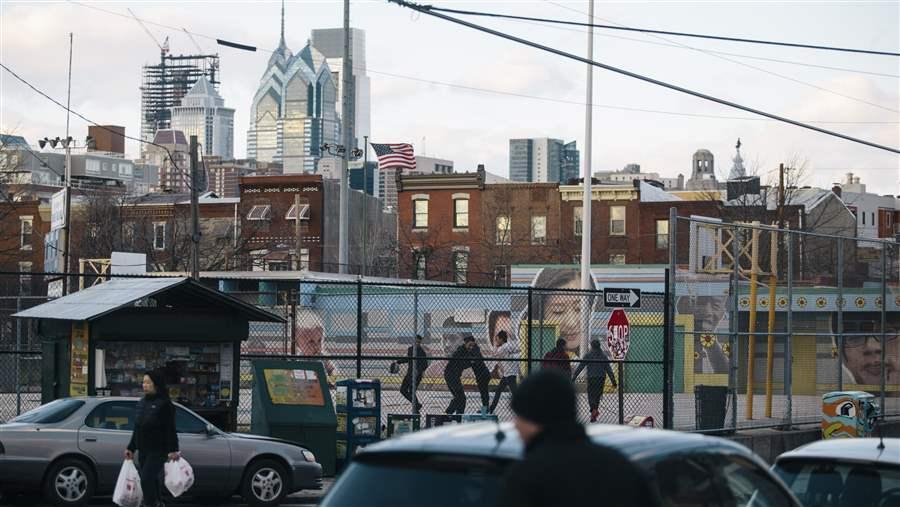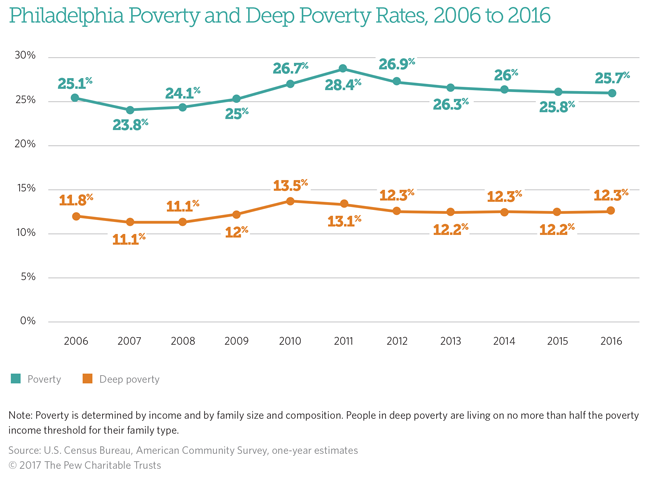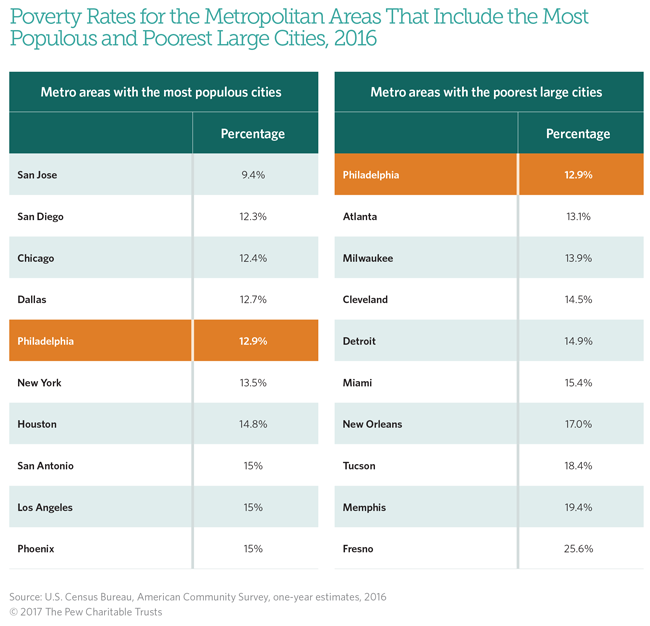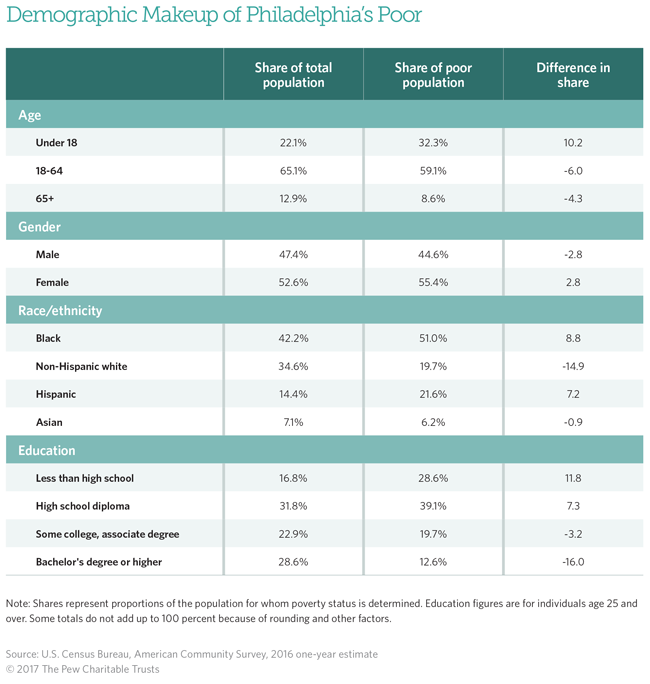Philadelphia's Poor
Who they are, where they live, and how that has changed
Overview
Poverty is one of Philadelphia’s most enduring problems. At 25.7 percent, the poverty rate is the highest among the nation’s 10 largest cities. About 400,000 residents—including roughly 37 percent of the city’s children under the age of 18—live below the federal poverty line, which is $19,337 in annual income for an adult living with two children. And nearly half of all poor residents are in deep poverty, defined as 50 percent below the federal poverty line.
One factor that helps explain this high poverty rate is the extraordinary degree to which the region’s poor are concentrated in the city. Philadelphia has only 26 percent of the region’s residents, but it is home to 51 percent of the poor, and that gap of 25 percentage points is among the largest for any region in the country. While the suburbanization of poverty has been much-discussed nationally and there are pockets of poverty in Philadelphia’s surrounding counties, the phenomenon has happened less in the Philadelphia area than in many other metropolitan areas. And at 12.9 percent, the region’s poverty rate is lower than that of most of the metropolitan areas that include the nation’s 10 largest cities.
This report focuses on the demographics and geography of poverty in Philadelphia and makes comparisons over time and among different cities. To do this, The Pew Charitable Trusts analyzed U.S. census data in the nation’s 10 most populous cities—New York; Los Angeles; Chicago; Houston; Phoenix; Philadelphia; San Antonio, Texas; San Diego; Dallas; and San Jose, California—and the 10 poorest cities with populations of at least 350,000: Detroit; Cleveland; Fresno, California; Memphis, Tennessee; Milwaukee; Philadelphia; Miami; Tucson, Arizona; New Orleans; and Atlanta.
The data showed that poverty in Philadelphia, the only city to appear on both lists, has been evolving, largely in ways that reflect the changing makeup of the city as a whole, especially in terms of race, ethnicity, and age. Compared with years past, Philadelphia’s impoverished residents are increasingly Hispanic and of working age. And poverty is spread across much of the city rather than limited to a few neighborhoods. But other elements have not changed: The city is still home to most of the region’s poor, and half of them are black.
Additional findings of the analysis include:
- From 1970 to 2016, the last year for which numbers were available, Philadelphia’s poverty rate rose by 10.3 percentage points while the nation’s poverty rate, now at 12.7 percent, was essentially unchanged. The rising rate in Philadelphia was the result both of an increase in the number of poor people living in the city and a decrease in the number of residents who are not poor.
- Among the cities that currently qualify as the 10 most populous, the increase in poverty in Philadelphia was the steepest over that 45-year period. Among the poorest large cities, the increase was about average.
- In recent years, Philadelphia’s poverty rate has been relatively stable. From 2006 to 2016, it grew by less than one percentage point, although it rose sharply for a time in the aftermath of the Great Recession. Most of the 10 largest cities had relatively small net changes in their poverty rates during this period, while many of the 10 poorest large cities had significant increases.
- Among racial and ethnic groups, Hispanics have the highest poverty rate in Philadelphia at 37.9 percent, followed by blacks at 30.8 percent.
- Over the past 45 years, poverty in the city has expanded geographically from discrete areas in North, West, and Southwest Philadelphia to much of the city; 40 percent of Philadelphians now live in census tracts with poverty rates under 20 percent. Blacks and Hispanics of all income levels are far more likely than whites to live in areas where the poverty rate is high; poor whites tend to live in neighborhoods where the poverty rate is low.
In this report, Pew looks at poverty in Philadelphia from two statistical perspectives. One is the poverty rate, which is the percentage of any group that is poor; this is the most commonly used measure. The other is the share of the city’s entire poverty-level population that is attributable to any one group, a number that reflects both the group’s poverty rate and the size of its overall presence in the city. For instance, the poverty rate for individuals ages 18 to 64 was 23.4 percent in Philadelphia in 2016, slightly lower than the citywide rate of 25.7 percent. But because nearly two-thirds of city residents were in this age group, they accounted for 59.1 percent of all Philadelphians living in poverty—their share of the city’s poverty population.
For those in poverty, life can be filled with struggle: finding safe, decent housing; feeding a family; and seeking work in neighborhoods where opportunities are few. And the city’s high level of poverty has impacts that reach far beyond those who live it on a daily basis.
Having roughly 400,000 poor people limits the tax revenue available to support government services; increases the demand for those services; and weighs on the economic performance of the city as well as the region. Many of the topics that dominate our nation’s urban conversation—including crime, health, and public education—are rooted in the economic status of cities’ less well-off residents. The goal of this analysis is to inform that conversation for local policymakers and for all who care about Philadelphia and its future.


Poverty and Connecting to Opportunity in Philadelphia
Episode 17


Philadelphia’s Poverty Rates Explained in Five Charts


Comparing Philadelphia's Geography of Poverty With Other Regions


Poverty in Philadelphia
See all of The Pew Charitable Trusts' research on this topic.











